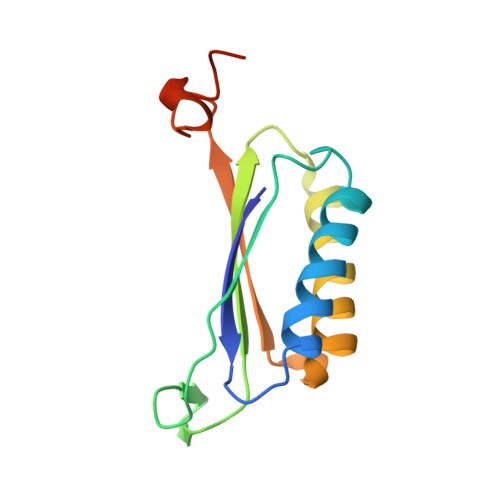Structural Basis for the Asymmetry of a 4-Oxalocrotonate Tautomerase Trimer.
Medellin, B.P., Lancaster, E.B., Brown, S.D., Rakhade, S., Babbitt, P.C., Whitman, C.P., Zhang, Y.J.(2020) Biochemistry 59: 1592-1603
- PubMed: 32242662
- DOI: https://doi.org/10.1021/acs.biochem.0c00211
- Primary Citation of Related Structures:
6VVM, 6VVN, 6VVR, 6VVW - PubMed Abstract:
Tautomerase superfamily (TSF) members are constructed from a single β-α-β unit or two consecutively joined β-α-β units. This pattern prevails throughout the superfamily consisting of more than 11000 members where homo- or heterohexamers are localized in the 4-oxalocrotonate tautomerase (4-OT) subgroup and trimers are found in the other four subgroups. One exception is a subset of sequences that are double the length of the short 4-OTs in the 4-OT subgroup, where the coded proteins form trimers. Characterization of two members revealed an interesting dichotomy. One is a symmetric trimer, whereas the other is an asymmetric trimer. One monomer is flipped 180° relative to the other two monomers so that three unique protein-protein interfaces are created that are composed of different residues. A bioinformatics analysis of the fused 4-OT subset shows a further division into two clusters with a total of 133 sequences. The analysis showed that members of one cluster (86 sequences) have more salt bridges if the asymmetric trimer forms, whereas the members of the other cluster (47 sequences) have more salt bridges if the symmetric trimer forms. This hypothesis was examined by the kinetic and structural characterization of two proteins within each cluster. As predicted, all four proteins function as 4-OTs, where two assemble into asymmetric trimers (designated R7 and F6) and two form symmetric trimers (designated W0 and Q0). These findings can be extended to the other sequences in the two clusters in the fused 4-OT subset, thereby annotating their oligomer properties and activities.













